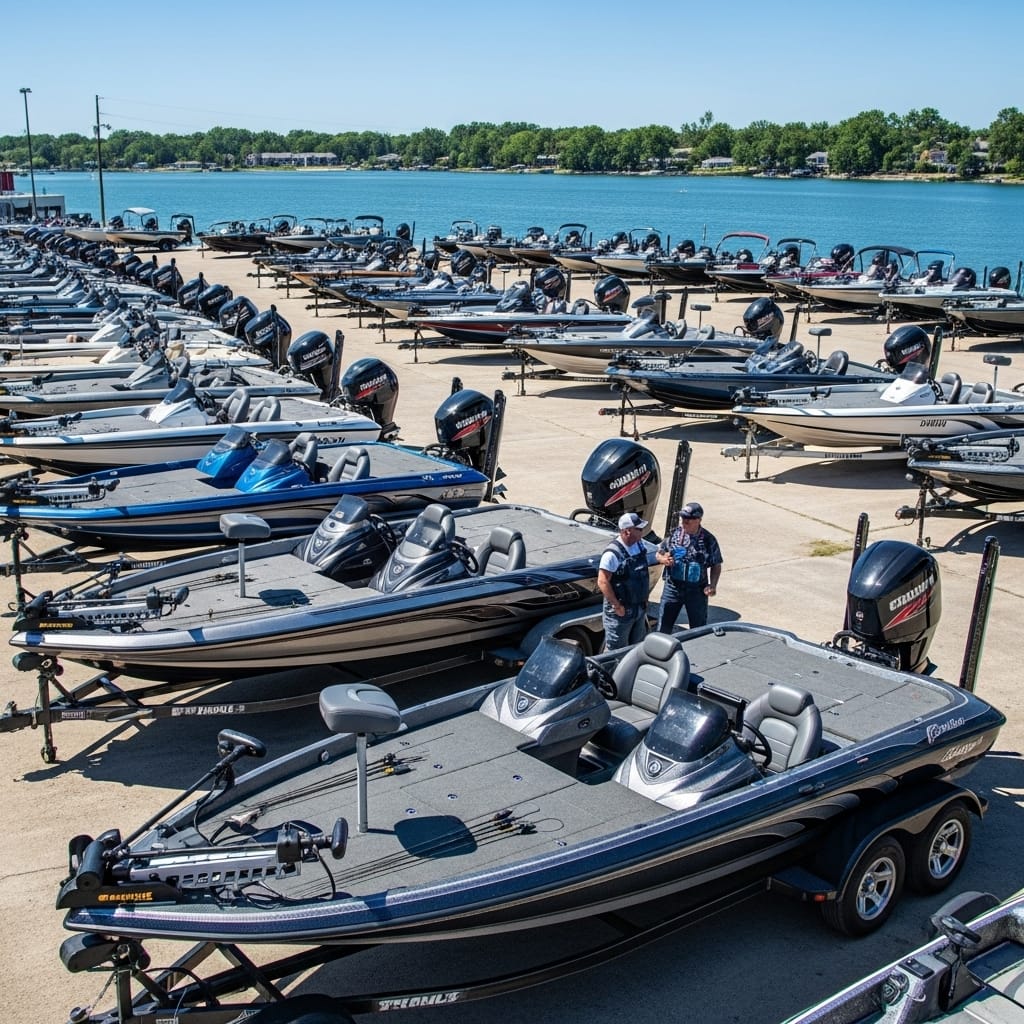
The Ultimate Guide to Finding the Perfect Bass Boat for Sale
The thrill of the chase, the gentle rock of the water, the explosive strike of a largemouth bass – for many, this is the pinnacle of outdoor recreation. At the heart of this passion lies a specialized vessel, a finely tuned machine designed for one primary purpose: to put you on the fish. We’re talking about the bass boat, a symbol of dedication to the art and science of bass fishing. If you’re hearing the call of the water and find yourself typing “bass boats for sale” into your search bar, you’ve come to the right place. This comprehensive guide will navigate you through the exciting, and sometimes complex, world of buying a bass boat, ensuring you find the perfect craft to fuel your angling adventures for years to come.
The Allure of the Bass Boat: More Than Just a Fishing Vessel
What sets a bass boat apart from a standard jon boat or a multi-purpose fishing vessel? It’s all in the design, a masterclass in form following function. These low-profile, sleek boats are built for speed, stability, and unparalleled fishability. The wide beam provides a remarkably stable casting platform, allowing multiple anglers to move about with confidence. The powerful outboard motor gets you to your favorite fishing spot in a hurry, a crucial advantage in tournaments or when you want to maximize your time on the water. But the true magic lies in the details: the raised casting decks at the bow and stern, the powerful and precise trolling motor for stealthy approaches, the sophisticated fish finders and GPS units that turn the murky depths into a readable map, and the cavernous storage lockers for an arsenal of rods, reels, and tackle. A bass boat isn’t just a way to get on the water; it’s an integrated fishing system designed to give you a competitive edge.
Fiberglass vs. Aluminum: The Great Debate

One of the first major decisions you’ll face when shopping for a bass boat is the hull material: fiberglass or aluminum. Each has its distinct advantages and is suited to different types of anglers and waterways.
The Case for Fiberglass
Fiberglass bass boats are the quintessential image that comes to mind for many. Their sleek, molded designs with high-gloss, metal-flake finishes are undeniably eye-catching. But their appeal is more than skin deep. Fiberglass hulls are generally heavier, which translates to a smoother, more stable ride in rough water. They tend to cut through waves rather than ride over them, providing a more comfortable experience on large lakes and reservoirs. The manufacturing process allows for more complex hull designs, which can enhance performance and on-the-water handling. Furthermore, fiberglass boats often feature more integrated storage and creature comforts, making them a popular choice for serious tournament anglers and those who demand the highest level of performance and features.
The Argument for Aluminum
Aluminum bass boats have come a long way from their simple, utilitarian roots. Modern aluminum models are durable, lightweight, and often more affordable than their fiberglass counterparts. Their lighter weight means they can be towed by a wider range of vehicles and often require a less powerful, more fuel-efficient outboard motor. Aluminum is also incredibly durable and forgiving. If you frequently fish in stumpy, rocky, or shallow rivers, an aluminum hull can withstand impacts that might cause significant and costly damage to a fiberglass boat. While they may not offer the same high-speed stability in rough water as fiberglass, they excel in smaller, more protected waterways and are an excellent choice for anglers looking for a tough, low-maintenance, and budget-friendly option.
Navigating the New vs. Used Market
With your ideal hull material in mind, the next crossroads is deciding between a brand-new boat or a pre-owned vessel. Both paths offer unique benefits and potential pitfalls.
The Shine of a New Boat
There’s nothing quite like the feeling of being the first owner of a new bass boat. You get the latest technology, the most current hull designs, and the peace of mind that comes with a full manufacturer’s warranty. You can often customize the boat to your exact specifications, choosing everything from the engine size and electronics package to the color scheme and carpet type. The downside, of course, is the cost. New boats represent a significant financial investment, and like a new car, they experience their steepest depreciation in the first few years. However, for those who want cutting-edge performance and the security of a warranty, buying new is often the preferred choice.
The Value of a Used Boat
The pre-owned market is where many aspiring bass boat owners find their perfect match. The biggest advantage is value. A boat that is just a few years old can often be purchased for a fraction of its original price, allowing you to get a much more capable and well-equipped boat for your budget. The previous owner has already absorbed the initial depreciation. However, buying used requires a greater degree of due diligence. A thorough inspection is paramount, and it’s highly advisable to enlist the help of a qualified marine surveyor or mechanic. You’ll need to carefully examine the hull, engine, electronics, and trailer to ensure you’re not inheriting someone else’s problems. Despite the extra homework, the potential for incredible value makes the used market a very attractive option.
Key Features to Scrutinize
Whether you’re looking at a brand-new model on a showroom floor or a pre-owned boat in someone’s driveway, there are several key components that demand your attention.
- The Engine: The outboard motor is the heart of your bass boat. It’s not just about horsepower; it’s about reliability and hours. For used boats, a compression test and a thorough inspection by a certified mechanic are crucial. Ask for service records and inquire about how the engine was maintained. For new boats, consider the manufacturer’s reputation and the availability of service centers in your area.
- The Trolling Motor: This is arguably one of the most important fishing tools on the boat. Look for a powerful, reliable trolling motor, preferably with modern features like GPS-enabled spot-lock, which can hold your boat in a specific position against wind and current. Check the batteries and the charging system as well.
- Electronics (Fish Finders/GPS): The “eyes” of your boat, modern electronics can make a world of difference. Look for large, high-resolution screens and units that offer features like side-imaging and down-imaging for a detailed view of the underwater world. Ensure the units power on and function correctly.
- The Hull: On a fiberglass boat, inspect the gel coat for any signs of deep scratches, cracks, or “spider-webbing,” which could indicate stress. Pay close attention to the transom, where the engine is mounted, ensuring it is solid and free of any flex or cracking. On an aluminum boat, look for any loose or popped rivets and signs of significant dents or tears in the hull.
- Storage and Livewells: A good bass boat should have ample dry storage for your gear and a reliable, well-aerated livewell system to keep your catch healthy. Open every hatch, check the seals, and test the livewell pumps and aerators.
- The Trailer: The trailer is an essential part of the package. Inspect the tires for wear and cracks, check the lights and brakes, and look for any significant rust or damage to the frame. The bunks that support the boat should be in good condition to prevent hull damage.
The Buying Process: From Viewing to Splashdown
Once you’ve identified a promising candidate, the process of making it your own begins. Start by arranging a viewing and, if possible, a sea trial. There is no substitute for getting the boat on the water to see how it performs. Pay attention to how it handles, how quickly it gets on plane, and how all the systems function under real-world conditions.
If you’re satisfied with the sea trial, it’s time to negotiate a price. Be prepared to make a reasonable offer based on the boat’s condition, age, and market value. Once a price is agreed upon, get everything in writing. A purchase agreement should outline the price, the items included in the sale, and any conditions of the sale, such as a satisfactory mechanical inspection.
Before finalizing the purchase, ensure the title is clean and there are no outstanding liens on the boat. You’ll also need to arrange for insurance and registration. Don’t overlook these administrative steps, as they are crucial for protecting your investment and ensuring you are legally able to operate your new boat.
Welcome to the Community
Buying a bass boat is more than just a transaction; it’s an entry ticket into a passionate and welcoming community. You’ll share stories, techniques, and camaraderie with fellow anglers at the boat ramp, in local tackle shops, and online. You’ll experience the thrill of early morning launches, the satisfaction of a well-executed cast, and the pure joy of being on the water, immersed in nature.
The journey to finding the perfect bass boat for sale requires patience, research, and a clear understanding of your needs and budget. Whether you choose a gleaming new fiberglass machine or a tried-and-true aluminum workhorse, the reward is a vessel that will unlock countless hours of fishing excitement and create memories that will last a lifetime. So do your homework, trust your instincts, and get ready to make some waves. The bass are waiting.






